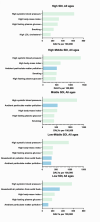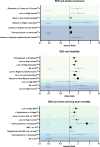Socioeconomic Status and Stroke: A Review of the Latest Evidence on Inequalities and Their Drivers
- PMID: 39697175
- PMCID: PMC11850189
- DOI: 10.1161/STROKEAHA.124.049474
Socioeconomic Status and Stroke: A Review of the Latest Evidence on Inequalities and Their Drivers
Abstract
The latest research on socioeconomic status (SES) and stroke continues to demonstrate that individuals with low SES are at a higher risk of stroke, receive lower-quality care, and experience poorer outcomes. Despite growing evidence on the impact of SES on stroke, gaps remain in understanding the underlying mechanisms and the influence of SES in different contexts, particularly in low- and middle-income countries. This narrative review builds upon our previous reviews from 2006 to 2015, focusing on studies published since 2015 to update on the influence of SES on stroke. Reports from nationwide or population-based observational studies in the past decade have confirmed that these inequalities persist globally and have provided new evidence on their mechanisms. In high-income countries, inadequate control of cardiovascular risk factors (hypertension, diabetes, obesity, and dyslipidemia) among lower socioeconomic groups has been found to explain much of the inequality in stroke risk. Exposure to particulate air pollution (both environmental and indoor from solid fuel cooking) synergizes with cardiovascular risk factors, especially hypertension, as major causes in low- and middle-income countries. Lower SES is persistently associated with disparities in care and increased poststroke disability and mortality. Lower SES also exacerbates other causes of health inequality among women, ethnic minorities, and migrants. Addressing stroke inequalities requires an interdisciplinary approach. Targeting cardiovascular risk factors, providing equitable quality of acute and rehabilitative stroke care, enacting legislative measures, and implementing societal changes remain leading global priorities.
Keywords: hypertension; mortality; risk factors; social class; stroke.
Conflict of interest statement
None.
Figures





References
-
- Cox AM, McKevitt C, Rudd AG, Wolfe CDA. Socioeconomic status and stroke. Lancet Neurol. 2006;5:181–188. doi: 10.1016/S1474-4422(06)70351-9 - PubMed
-
- Marshall IJ, Wang Y, Crichton S, McKevitt C, Rudd AG, Wolfe CDA. The effects of socioeconomic status on stroke risk and outcomes. Lancet Neurol. 2015;14:1206–1218. doi: 10.1016/S1474-4422(15)00200-8 - PubMed
-
- Adler NE, Ostrove JM. Socioeconomic status and health: what we know and what we don’t. Ann NY Acad Sci. 1999;896:3–15. doi: 10.1111/j.1749-6632.1999.tb08101.x - PubMed
-
- Galobardes B, Lynch J, Smith GD. Measuring socioeconomic position in health research. Br Med Bull. 2007;81–82:21–37. doi: 10.1093/bmb/ldm001 - PubMed
-
- Ferrari R. Writing narrative-style literature reviews. Med Writ. 2015;24:230–235. doi: 10.1179/2047480615Z.000000000329
Publication types
MeSH terms
Grants and funding
LinkOut - more resources
Full Text Sources
Medical
Miscellaneous

